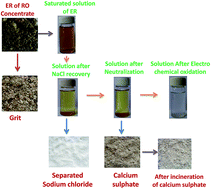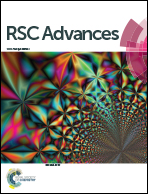Electrochemical treatment of evaporated residue of reverse osmosis concentrate generated from the leather industry†
Abstract
Reverse Osmosis (RO) concentrate generated from the leather industry is evaporated through solar pans/multiple effect evaporators as a disposal technique. The evaporated residue (ER) mainly consists of chloride and sulphate ions along with partially oxidized/fresh organic compounds. Earlier studies from us concluded that chloride and sulphate ions could be successfully separated by a selective ion precipitation technique from the saturated solution of ER. In the present investigation, organic compounds present in the ER solution were attempted to be treated by electrochemical oxidation using three different electrode systems: Cu–graphite/Cu–graphite, Ti-MMO/Cu–graphite and SS304/Cu–graphite. Amongst the studied electrode systems Cu–graphite/Cu–graphite and Ti-MMO/Cu–graphite electrode systems were found to be more effective in destruction of organic compounds from ER solution than the SS304/Cu–graphite system at a current density of 50 mA cm−2. The calculated specific energy consumption for the selected electrode system was found to be in the order of Cu–graphite/Cu–graphite > Ti-MMO/Cu–graphite > SS304/Cu–graphite at 50 mA cm−2 for ER treatment. Furthermore the hazardous total trihalomethanes (TTHMs) generated in electrochemical oxidation were removed by adsorption through a mesoporous activated carbon packed bed (MACPB) column. The results revealed that the electrochemically oxidized solution could satisfy the discharge limit after passing through a MACPB column.


 Please wait while we load your content...
Please wait while we load your content...